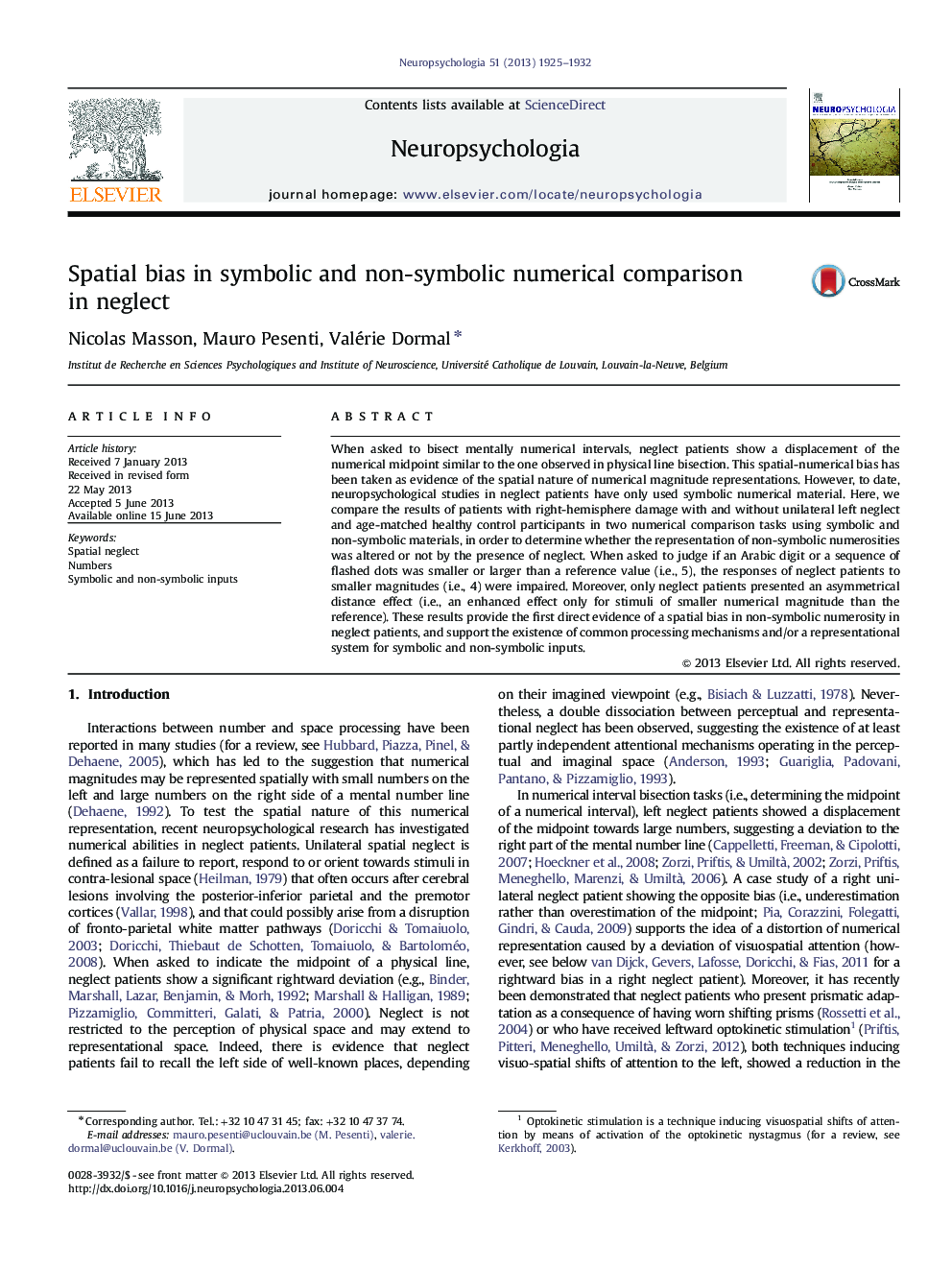| کد مقاله | کد نشریه | سال انتشار | مقاله انگلیسی | نسخه تمام متن |
|---|---|---|---|---|
| 10464786 | 925704 | 2013 | 8 صفحه PDF | دانلود رایگان |
عنوان انگلیسی مقاله ISI
Spatial bias in symbolic and non-symbolic numerical comparison in neglect
ترجمه فارسی عنوان
تعصب فضایی در مقایسه عددی نمادین و غیر نمادین در غفلت
دانلود مقاله + سفارش ترجمه
دانلود مقاله ISI انگلیسی
رایگان برای ایرانیان
کلمات کلیدی
بی توجهی فضایی، شماره، ورودی های نمادین و غیر نمادین،
ترجمه چکیده
وقتی که خواسته شد تا فواصل عددی ذهنی را با هم بسنجند، بیماران بی توجهی نشان می دهند که جابجایی نقطه اوج عددی شبیه به یک دید در خط فیزیکی است. این تعصب عددی فضایی به عنوان شواهدی از ماهیت فضایی بازنماییهای عددی به دست آمده است. با این حال، تا به امروز، مطالعات نوروپسیکتیک در بیماران غیروابسته تنها از مواد عددی نمادین استفاده می کنند. در اینجا، ما نتایج بیماران مبتلا به صدمه راست نیمکره با یا بدون غفلت از طرف مقابل و طرفداران کنترل همجنسگرا در دو مقیاس سالم را در دو وظیفه مقایسه عددی با استفاده از مواد نمادین و غیر نمادین مقایسه می کنیم تا مشخص شود آیا نمایندگی غیر نمادین با وجود غفلت، تعداد عادتها تغییر کرده است یا نه. هنگامی که خواسته شد قضاوت کند که آیا یک رقم عربی یا یک دنباله از نقاط فلش کوچکتر یا بزرگتر از یک مقدار مرجع (یعنی 5)، پاسخ بیماران غفلت به مقادیر کوچک (یعنی 4) کاهش یافته است. علاوه بر این، تنها غفلت از بیماران، اثری از فاصله فاصله نامتقارن را ارائه داد (به عنوان مثال، اثر افزایش یافته تنها برای محرک های عددی کوچکتر نسبت به مرجع). این نتایج نخستین شواهد مستقیمی برای یک تعصب فضایی در تعداد اندکی غیر نمادین در بیماران غیروابسته و حمایت از وجود مکانیسم های پردازش مشترک و / یا سیستم نمایندگی برای ورودی های نمادین و غیر نمادین است.
موضوعات مرتبط
علوم زیستی و بیوفناوری
علم عصب شناسی
علوم اعصاب رفتاری
چکیده انگلیسی
When asked to bisect mentally numerical intervals, neglect patients show a displacement of the numerical midpoint similar to the one observed in physical line bisection. This spatial-numerical bias has been taken as evidence of the spatial nature of numerical magnitude representations. However, to date, neuropsychological studies in neglect patients have only used symbolic numerical material. Here, we compare the results of patients with right-hemisphere damage with and without unilateral left neglect and age-matched healthy control participants in two numerical comparison tasks using symbolic and non-symbolic materials, in order to determine whether the representation of non-symbolic numerosities was altered or not by the presence of neglect. When asked to judge if an Arabic digit or a sequence of flashed dots was smaller or larger than a reference value (i.e., 5), the responses of neglect patients to smaller magnitudes (i.e., 4) were impaired. Moreover, only neglect patients presented an asymmetrical distance effect (i.e., an enhanced effect only for stimuli of smaller numerical magnitude than the reference). These results provide the first direct evidence of a spatial bias in non-symbolic numerosity in neglect patients, and support the existence of common processing mechanisms and/or a representational system for symbolic and non-symbolic inputs.
ناشر
Database: Elsevier - ScienceDirect (ساینس دایرکت)
Journal: Neuropsychologia - Volume 51, Issue 10, August 2013, Pages 1925-1932
Journal: Neuropsychologia - Volume 51, Issue 10, August 2013, Pages 1925-1932
نویسندگان
Nicolas Masson, Mauro Pesenti, Valérie Dormal,
